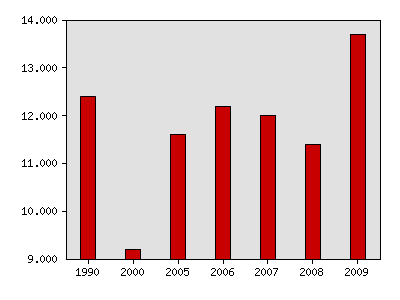Indicator 1: Child Poverty


Rationale: Poverty can do both immediate and lasting harm to children. Children who grow up in poverty are more likely to lack adequate food and clothing, live in poor housing, become victims of crime and violence, lack basic health care and be less successful in school.
About this indicator: Child poverty rates have fluctuated along with shifts in the economy. The percentage of related children under age 18 living in households below the federal poverty line rose from 10.2 percent in 1980 to 12.4 percent in 1989, fell to 9.2 percent in 1999, and then rose again to 13.7 percent in 2009. Household poverty is the most direct indicator of the economic status of children.
The poverty line is a federal estimate of the pretax annual income needed to meet basic living costs, adjusted for family size. In 2009, the poverty level for a family of four with two children was $21,756.
The poverty line is a federal estimate of the pretax annual income needed to meet basic living costs, adjusted for family size. In 2009, the poverty level for a family of four with two children was $21,756.
Percent of Minnesota children below poverty

| Year | Data |
|---|---|
| Percent of Minnesota children below poverty, U.S. Census Bureau | |
| 1990 | 12.4% |
| 2000 | 9.2% |
| 2005 | 11.6% |
| 2006 | 12.2% |
| 2007 | 12% |
| 2008 | 11.4% |
| 2009 | 13.7% |
For comparison: Nationally, in 2009, 19.7 percent of related children under 18 were below poverty. This is significantly above the Minnesota rate of 13.7 percent.
Historically, poverty rates in Minnesota are highest among American Indian children, closely followed by African American families. Child poverty is also considerably higher in Hispanic and Asian families than in non-Hispanic White families
Technical notes: The 1990 and 2000 numbers come from the Decennial Census. Other years come from the American Community Survey conducted by the U.S. Census Bureau. The U.S. Department of Commerce adjusts the poverty level annually to reflect changes in the Consumer Price Index. Poverty rates can also be found in the Current Population Survey, but the estimates are based on smaller survey samples.
Sources:
- U.S. Bureau of the Census, Decennial Census, 1980, 1990 and 2000, http://www.census.gov/.
- American Community Survey, http://www.census.gov/
Related 2002 Milestones indicator:
Local data:




